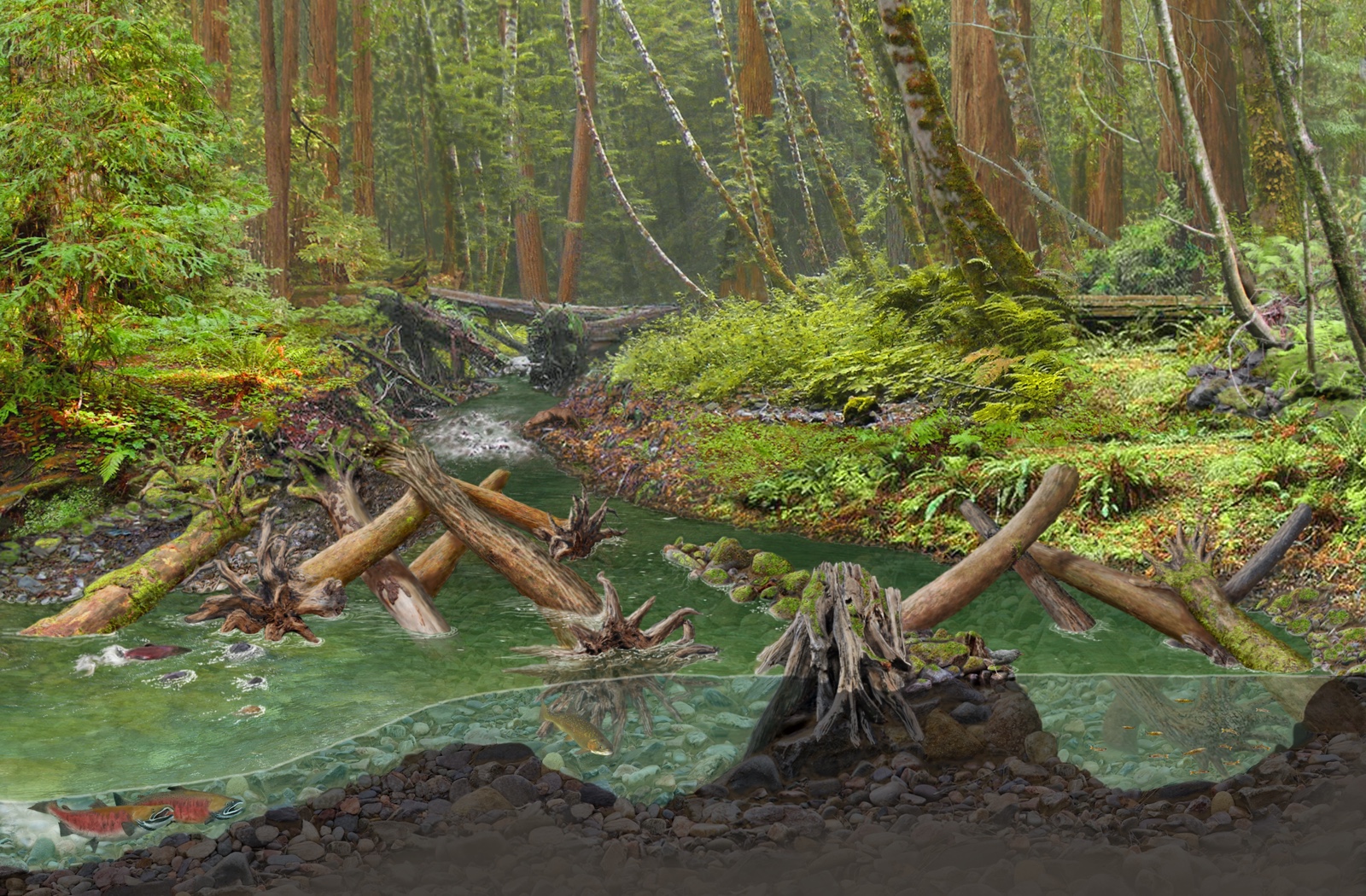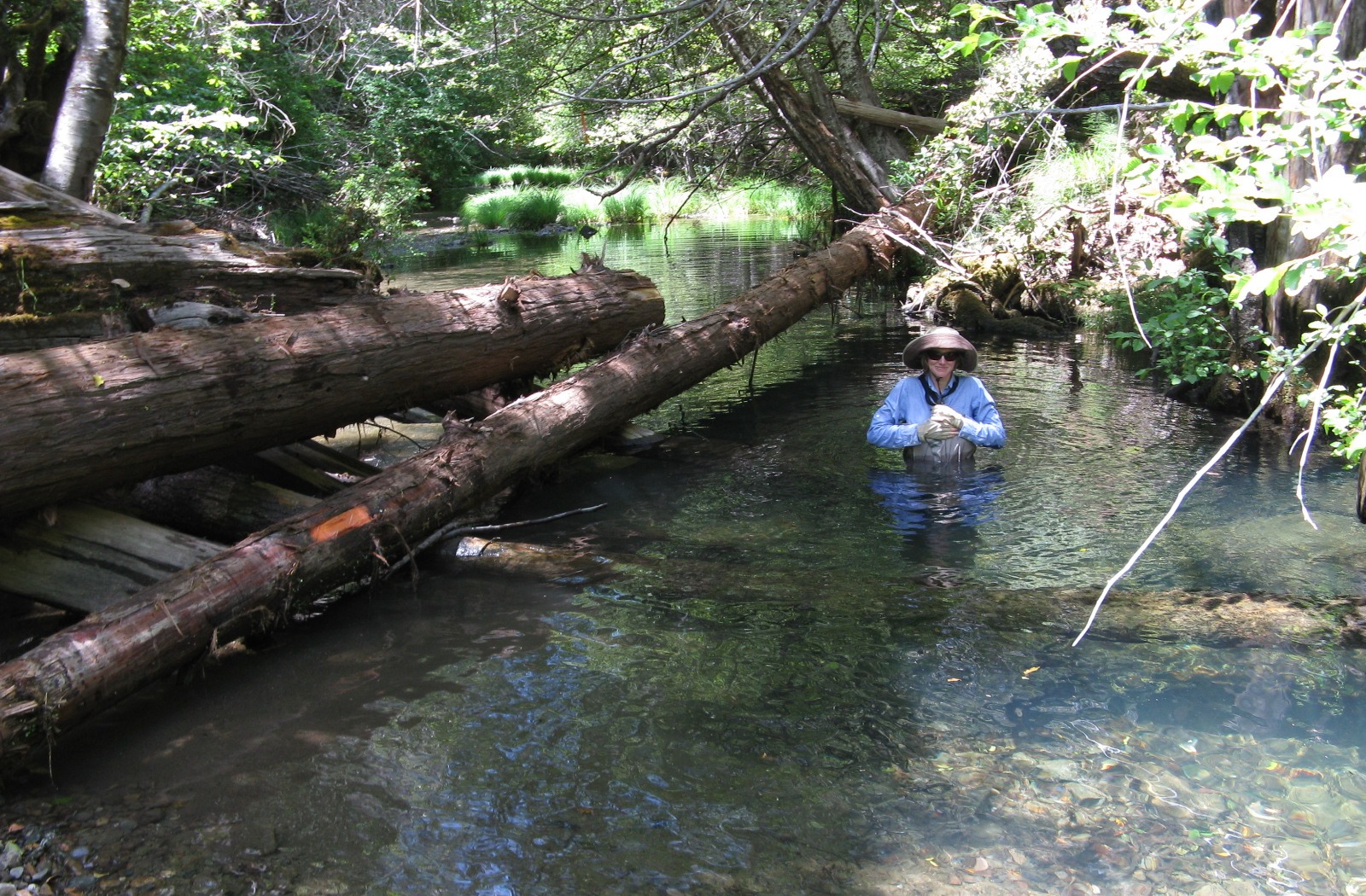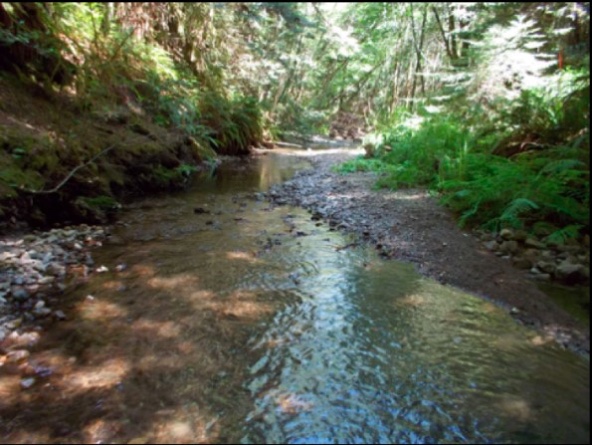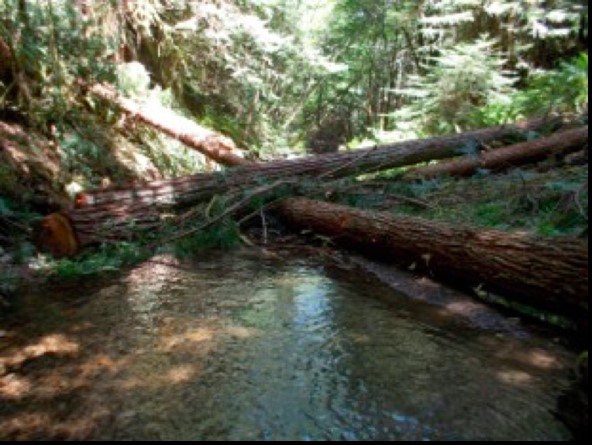How can we quickly and cheaply accelerate the restoration of salmon habitat?

Restoration of salmon populations in the coastal watersheds of northern California can be accelerated by placing woody debris in stream corridors. The photo shows wood jams, gravel accumulations, and pools that were scoured on Signal Creek in the Garcia River Forest. Photo: Jonathan Warmerdam.
In coastal watersheds throughout the northwest, salmon and steelhead populations have suffered dramatic declines. A key driver of many of these declines is the legacy of past logging practices, which have left many streams choked with sediment and cleared of the forest overstory. Mature, forested riparian buffers provide not only shade but also downed material that adds important complexity to the stream channel.
Old, downed trees play an important role in salmon survival. When the trees fall into streams, the trunks dig out deep pools, and cause gravel to settle. The gravelly ends of pools are ideal substrate for salmon to lay eggs in winter. In the summer, young salmon use the pools to feed and grow before their outmigration to the sea.
Thus, one way conservationists and timber companies have tried to restore salmon populations is by building engineered wood structures using logs, steel cable, and pins that attempt to recreate natural wood jams. These constructed projects, however, are expensive and often fail to create the intended habitat.

Woody debris in streams creates habitat necessary for spawning and rearing of salmon. Illustration by Owen Caddy.

At Inman Creek, a wood jam scoured out a deep pool providing ideal salmon habitat. Photo: Christopher Blencowe
Conservancy scientists started testing a simpler approach in 2009, one that mimics nature more closely. With our local partners in Mendocino County, we placed large, long trees in specific locations in rivers and streams. Some were placed loosely and others wedged against trees or rocks. As trees were carried downstream during winter flow, they formed natural wood jams.

South Fork Garcia River, before treatment, June 2014

Post-Treatment, 2014
We tested this approach over six years along 45 miles of stream, and found that this method reliably creates habitat for salmon. The woody debris dug out pools, collected spawning gravels, and provided the fish cover from predators, just as fallen trees would have. And importantly, it costs roughly one-fifth the price of the more engineered approach.
Although the more traditional engineered log structures would be the more appropriate method in some cases (such as when there are bridges or other infrastructure downstream, or in very large streams), we have shown that for many streams simply adding long logs back into the stream channel is effective.
Importantly, it demonstrates a cost-efficient way to accelerate the restoration of habitat in these watershed – which can play an important part in the recovery of these iconic fish species.
Prepared by Anchor QEA, LLC (John Ferguson, Elizabeth Greene, and Michelle L. Ratliff), Contributors and Participants: John Cain, Jon Rosenfield, Alison Weber-Stover, Stephen Louie, John Shelton, Tim Heyne, Brian Ellrott, Sierra Franks, Monica Gutierrez, Rhonda Reed, David Swank, Steve Edmundson, Katie Schmidt, Rachel Johnson, Jeanette Howard, Julie Zimmerman, Chris Carr, Daniel Worth, Rene Henery, Ron Yoshiyama, Joshua Israel, Paul Cadrett, Ramon Martin, and J.D. Wikert
Also view Appendix A: Stanislaus Survival Model and and other report Appendices.Travis M. Hinkelman, Myfanwy Johnston, Joseph E. Merz, Julie Zimmerman
To restore degraded stream corridors and develop large-scale, sustainable watershed conservation strategies, it is essential for managers to consider—in order to ultimately…Jennifer K. Carah, Christopher C. Blencowe, David W. Wright
Coho salmon in California are critically imperiled so there is strong impetus to achieve as much habitat restoration as possible in priority watersheds quickly and with limited resources. This paper…Jennifer Carah, Jason Pelletier
A two-page summary of salmon restoration efforts at the Garcia River Forest on the North Cost of California focusing on the reintroduction of wood in streams as a strategy.The Nature Conservancy, Jennifer Carah
Salmon and trout thrive in streams with cool water, low levels of sand and silt, and deep, shaded pools. Intensive forest management in California over the last 150 years led to the removal of these…